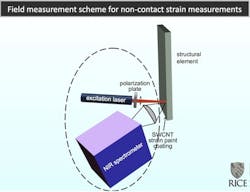Rice University’s fluorescent nanotube paint reveals mechanical strain
Houston, TX--A paint made with semiconducting carbon nanotubes at Rice University can help detect strain in buildings, bridges, and airplanes. The study, published online this month by the American Chemical Society journal Nano Letters, details a composite coating that could be read by a handheld IR spectrometer.
The method could tell where a material is showing signs of deformation well before the effects become visible to the naked eye, and without touching the structure. The researchers said this provides a big advantage over conventional strain gauges, which must be physically connected to their read-out devices. In addition, the nanotube-based system could measure strain at any location and along any direction.
Rice chemistry professor Bruce Weisman led the discovery and interpretation of near-IR fluorescence from semiconducting carbon nanotubes in 2002, and has since developed and used novel optical instrumentation to explore nanotubes’ physical and chemical properties. Satish Nagarajaiah, a Rice professor of civil and environmental engineering and of mechanical engineering and materials science, and his collaborators led the 2004 development of strain sensing for structural integrity monitoring at the macro level using the electrical properties of carbon nanofilms, which are dense networks of nanotubes. Since then he has continued to investigate novel strain sensing methods using various nanomaterials.
Fortuitous professorial interaction
At a NASA workshop in 2010, Weisman gave a talk on nanotube fluorescence. As a flight of fancy, he said, he included an illustration of a hypothetical system that would use lasers to reveal strains in the nanocoated wing of a space shuttle. “I went up to him afterward and said, ‘Bruce, do you know we can actually try to see if this works?’” recalls Nagarajaiah.
Nanotube fluorescence shows large, predictable wavelength shifts when the tubes are deformed by tension or compression. The paint would suffer the same strain as the surface it’s painted on and give a clear picture of what’s happening underneath.
Weisman said the project will require further development of the coating before a product can go to market. “We’ll need to optimize details of its composition and preparation, and find the best way to apply it to the surfaces that will be monitored,” he says. “These fabrication/engineering issues should be addressed to ensure proper performance, even before we start working on portable readout instruments. There are also subtleties about how interactions among the nanotubes, the polymeric host and the substrate affect the reproducibility and long-term stability of the spectral shifts. For real-world measurements, these are important considerations."
But none of those problems seem insurmountable, he says, and construction of a handheld optical strain reader should be relatively straightforward.
Lead author of the paper is Paul Withey, an associate professor of physics at the University of Houston-Clear Lake, who spent a sabbatical in Weisman’s lab at Rice studying the fluorescence of nanotubes in polymers. Co-authors are Rice civil engineering graduate student Venkata Srivishnu Vemuru in Nagarajaiah’s group and Sergei Bachilo, a research scientist in Weisman’s group.

John Wallace | Senior Technical Editor (1998-2022)
John Wallace was with Laser Focus World for nearly 25 years, retiring in late June 2022. He obtained a bachelor's degree in mechanical engineering and physics at Rutgers University and a master's in optical engineering at the University of Rochester. Before becoming an editor, John worked as an engineer at RCA, Exxon, Eastman Kodak, and GCA Corporation.
